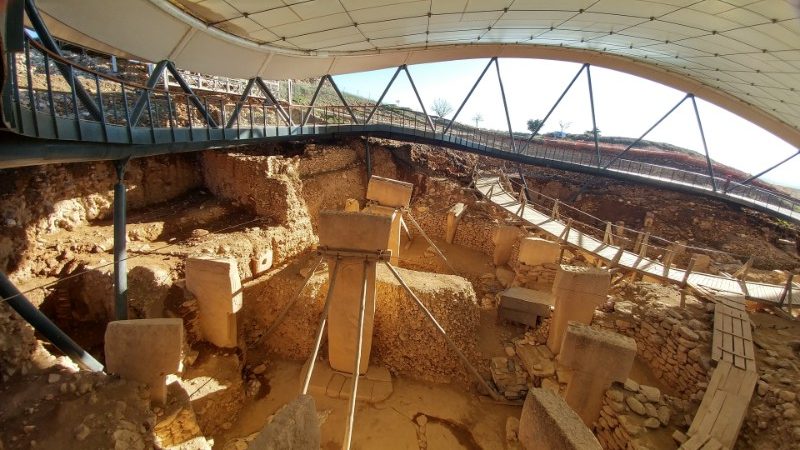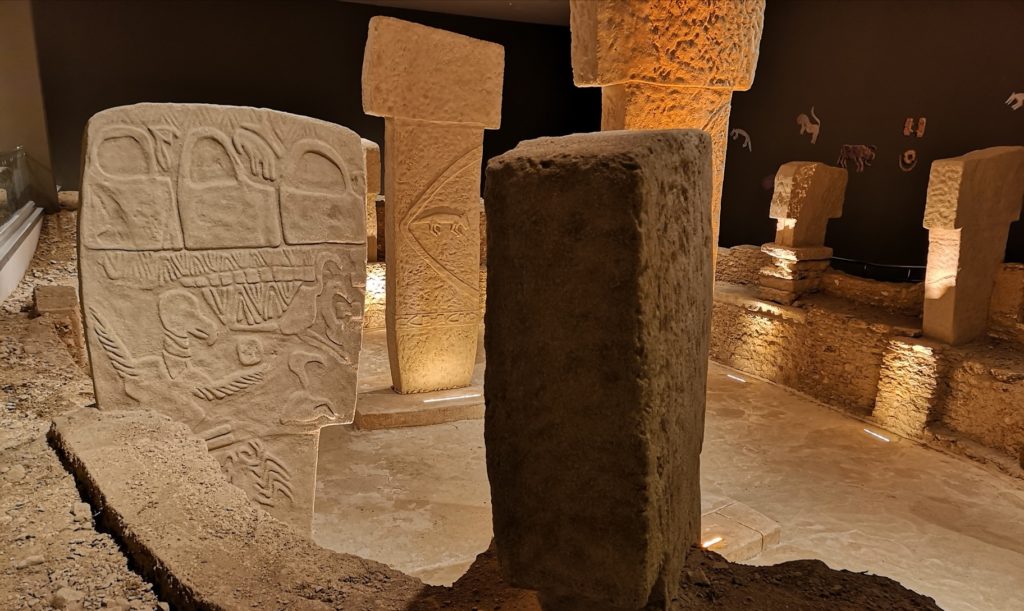
“What is it with the handbags”?
A huge amount of energy is expended on the subject of “bags” because this particular accessory seems to appear right across the world in ancient art and monumental sculpture. It transcends both geography and time. It is a ubiquitous feature and, as a result, has invited a huge amount of speculation and generated a huge amount of discussion, often quite heated discussion. The bags are frequently assigned a magical or mystical purpose and additionally, are cited as evidence supporting a range of diffusionist hypotheses. I am not going to comment on this aspect of the phenomenon, other than to say that in my simple interpretation…..in a world with no pockets: bags.
However, here I want to restrict myself to this feature as it appears at Göbekli Tepe, although there are some associated matters that need explanation first. The general argument is that the “hand bags” at Göbekli Tepe fit into the same pattern as all the other depictions of bags carried by figures in art across this wider region and, indeed, further afield. Göbekli Tepe is presented as the earliest depiction of this motif. However, I would argue that the motif as it appears at Göbekli Tepe, is entirely different and, as far as I am aware, unique.
The first point to make is that these motifs appear, so far, on one pillar only. They appear on the much discussed and debated Pillar 43, also known as the Vulture Stone, as an integral part of some kind of story board. Before one can undertake any meaningful appraisal one has to consider the context of Göbekli Tepe in time and the culture that produced it. Various claims are made regarding the imagery of Pillar 43 but before we embark on a cosmological journey that imbues Göbekli Tepe’s builders with extraordinary astronomical knowledge that features in much of the speculative discourse, let’s look at it for what it is, a product of a pre agricultural, pre writing, pre pottery Stone Age culture of hunter gatherers. It is obvious that the night sky would have had a profound impact on a culture living in such proximity to nature because it would be a dominant feature of a large part of their lives. Most people today, living in urban environments where light polution is high, simply never see the night sky and probably don’t think about it. This does not mean, however, that the people who built Göbekli Tepe understood astronomy. They didn’t and suggesting that they did is a huge assumption. For them, the night sky would have been a mystical part of their life story; a part of nature. They may well, and probably did in fact, attribute representation of important creatures to stars in the night sky. Equally clearly, cosmic myths would have often been contradictory, even in the same group. This is true today and can be seen by reading Christian scripture and Holy Texts, but to assume their values correlate to modern astrology or a modern zodiac is presumptive.
The iconography of Pillar 43 should be read in the context of a culture for whom the role of the dead and practices around death and the handling of cadavers was an integral part. Across the wider region we have a culture which revered skulls as a part of the veneration of ancestors and practised the defleshing of bodies, often in conjunction with carrion eating birds, particularly the vulture. If we know this then the Pillar’s dominant image of a vulture holding a ball (reasonably interpreted as a head, or a representation of a head) just above a scorpion and a headless man with an erection, makes sense the way a “star map,” a currently popular interpretation, doesn’t.
The animals depicted on Pillar 43 are, variously, a vulture, a crane, snake, scorpion, an unidentified bird and, partially obscured by the stone wall into which the pillar is placed, a dog or fox shaped animal and another snake. These are all animals with which these people would have been familiar, and taken in conjunction with the totality of animal images at the site and the physical animal remains recovered during excavations, represent the full panoply of cultural and economic interactions one can expect from a culture at this level of development. It’s worth noting, as a passing observation, that the back side of Pillar 43 is unadorned, has not been carefully smoothed out, and clearly shows evidence of the pitted, chipping process used to shape and carve the stones and pillars using simple stone tools.
This leads us to the “hand bags.” A lot is made of this motif. A good recent example is a paper and a book written by Martin Sweatman, an enthusiastic amateur, who claims the “hand bags” are in fact “sunset symbols representing the equinoxes and solstices”. The claim made by Sweatman is that various (apparently randomly selected) pillars and images around the site depict astronomical and cosmic events, particularly the enigmatic Pillar 43 which is, he says, an astronomical “date stamp” depicting a particular cosmic event. Specifically he claims it marks the so-called “Younger Dryas Impact” event. He claims that statistical analysis “proves” his case. There are specific objections to this interpretation based on archaeological data but, let’s take a step back and look at this afresh. We must appreciate that hunter gatherer societies don’t do astronomy. We can reference enough current hunter gatherer cultures, or their recent antecedents, to know this. They have a complex and sophisticated mythology which connects them to the cosmos but this does not equate with astronomy. Astronomy is a function of more sedentary and settled life that takes time to evolve. Hunter gatherers have a more intimate and familial relationship with the cosmos. A good example would be the belief common amongst some San and Tswana peoples in southern Africa that the Sun, at dusk in the west, draws a “blanket of darkness” around himself to keep warm but, because the blanket is old and has many small holes, the light of the Sun comes through. These are the stars we see at night. But beliefs do vary. Other San people, notably the !Kung, avoid the Sun at certain rites of passage. Among these are a girl’s first menstruation. marriage, birth and death rites. Rites at these times can only be conducted at the setting of the Sun when the Sun’s power is diminished. This is the way hunter gatherers see the cosmos and relate to it. Trying to impose a statistical tool to validate invalid assumptions won’t change this. Statistical methods can “prove” quite literally anything, as Martin Sweatman unintentionally demonstrates. In 1992 Dutch Astrophysicist Cornelius de Jager demonstrated that the dimensions or arrangement of any object or objects can be manipulated to produce a desired result. He derived the speed of light and the distance from the earth to the sun using the dimensions of a bicycle. He doesn’t specify which make of bicycle but it would be extremely unlikely that its makers had this correlation in mind.
The archaeological team who are excavating the site are open to sensible ideas on this point but they discount astronomy and suggest that the three “bag” images may be depictions of enclosures which are roofed but which are identified by animals that may be clan or tribe markers, or possibly simply totems. This would be a rational proposition given what we know, as opposed to what one might simply assert. It’s certainly congruent with what we do know while the Sweatman assertion simply isn’t. That said there is an alternative that works better, which I’ll address shortly.
Graham Hancock, the doyen of the diffusionist, revisionist community, makes similar observations about these bags but is more interested in the cultural context than the astronomical one. He tries to make a connection based on what he says is a very close visual match, with not only bag carrying entities from later Sumerian mythology, but also with figures from Mesoamerican mythology. If we ignore the fact that the “bags” are not the same, and we likewise ignore a host of other objections that he does not address, Hancock goes on to suggest, in the form of a rhetorical question in “Magicians of the Gods,” that the “bags” are a kind of Badge of Office of a civilising agent. Could it be, he asks, that as “far back as 9600 BC – the epoch of Göbekli Tepe where many of the same symbols are found and where, although we have no surviving legends, the signs of a civilising mission in the form of the sudden appearance of agriculture and monumental architecture are everywhere to be seen…”are, the result of this external, common agent? Hancock has simply replaced Sweatman’s sophisticated statistical tool with the blunter “since they kind of look alike, they must be connected” tool.
The answer to both date stamp assertion and diffusionist question in this instance has to be a resounding ”No!”
So, if not a cosmic date stamp and if not a cultural artefact acting like a trail of breadcrumbs on a cultural journey through time, then what?
The answer, as is so often the case, is both simple and hiding in plain sight. Again, look at the problem from the view point of a hunter gatherer or even just a country boy familiar with wildlife. They will give you the answer. Each of these “bags” with an animal poised right by them, is a simple, but effective animal trap. Using a shallow depression or pit with a twine loop and bent sapling or branch as a spring, this simple trap has been used for thousands of years and is still used today. Looking at the carving it is quite clear, even down to the grassy setting in which the engraver has positioned the images of the traps and the intended victims, this should be obvious, once the observer’s perception has been jogged.
In modern countries with their urbanised populations, it’s no surprise that people don’t recognise this simple but effective technology. It is considered a fringe, or even arcane art, not even deserving of the label “technology” but there are people who actually make a living teaching these old skills. Urbanites, history enthusiasts and would-be survivalists can enrol in bush craft courses to learn all about it. An excellent practitioner of these ancient skills is the Master Flint Knapper and Neolithic Survivalist Will Lord from Suffolk in England (learn more at the link below), but similar courses can be found in Europe and North America. However, I grew up in Africa where I spent a large part of my teenage years in the bush. I have seen people setting these traps to catch small game many times. The traps are adaptable because the technology is basic and all the materials to make one are readily at hand. A hunter can use the basic format to catch anything from medium sized game like gazelle to small antelope like the Duiker, down to small rodents like rabbits and even guinea pigs. The system can be modified to catch birds or even snakes. These people ate absolutely everything.
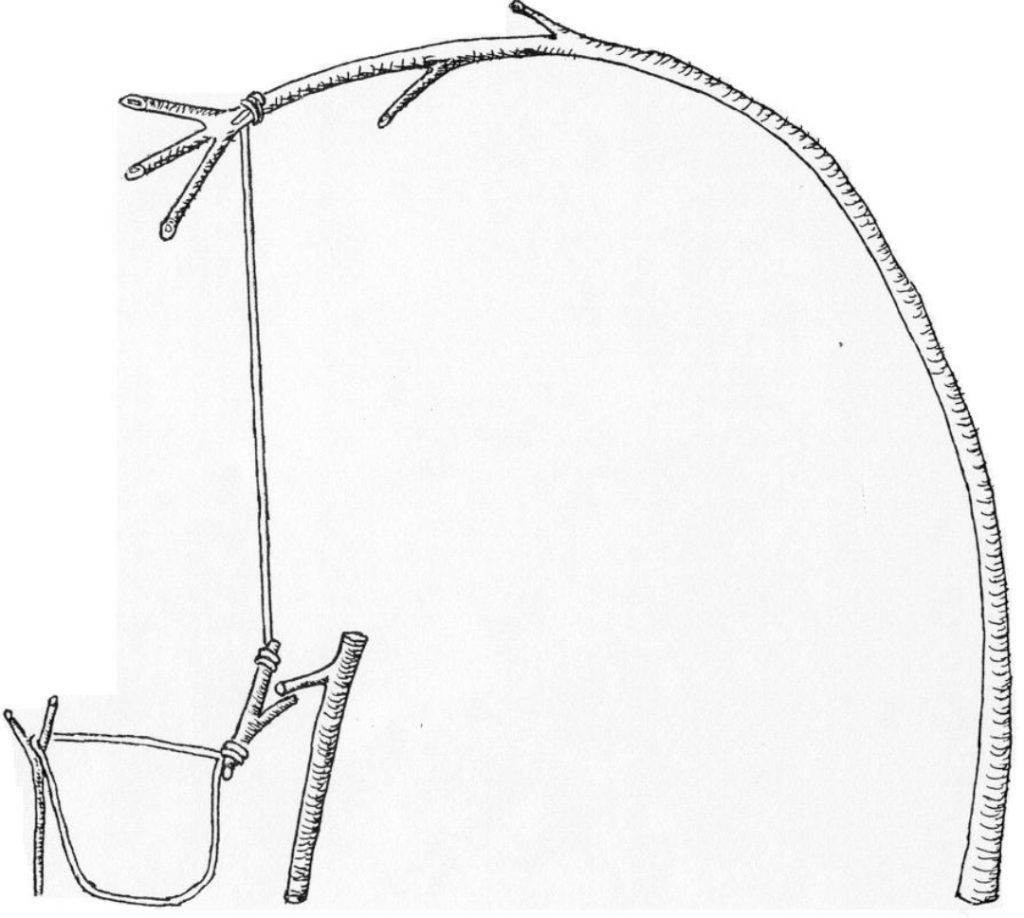
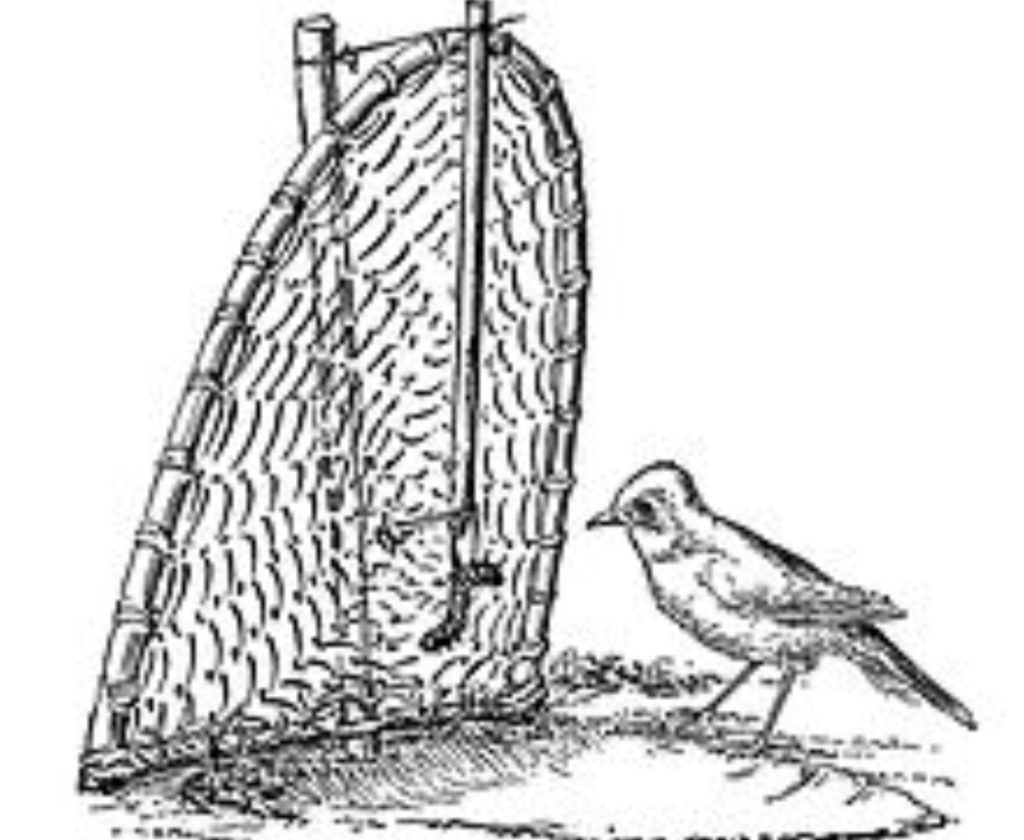
For that reason, it’s to Africa that I will go for my visual evidence. The San Bushmen of the Kalahari have left extensive archaeological evidence of their daily lives across Southern Africa. Their original home was extensive and concentrated further east in the Drakensberg Mountains, but they were driven out of this area by the encroachment of white settlers from the South and Zulu expansion to the North during a period of general forced migration known as the Mfecane, or “scattering.” But being highly adaptive hunter gatherers, they were able to integrate into the hostile, marginal environment of the Kalahari. They’re still there today, albeit in dwindling numbers, but their skills are in daily use and can be observed. The Göbekli Tepe trap is an essential part of their survival tool kit.



San Bushmen of the Kalahari setting the bough sprung Göbekli Tepe animal trap
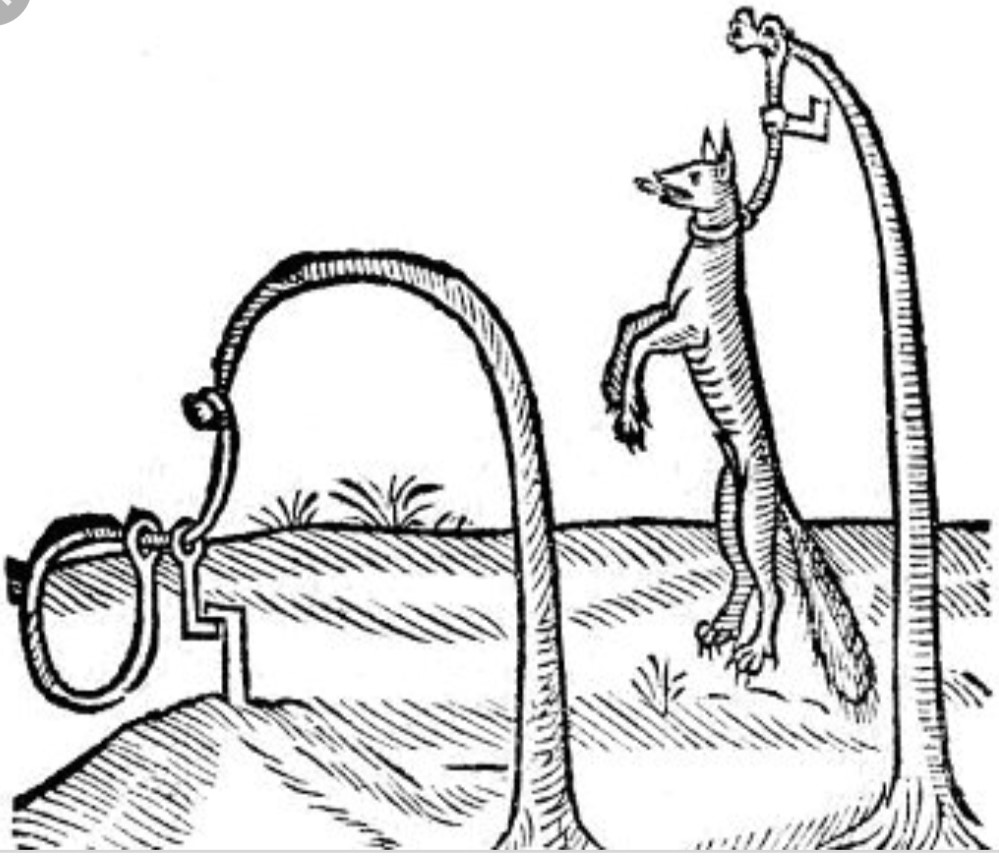
A 17th century wood cutting showing this type of bough sprung trap in action.
All the hard data that we have on Göbekli Tepe, both from the site itself, and from other archaeological sites in the wider region, are telling us that this is a culture of pre agricultural, pre writing, pre pottery hunter gatherers just making the slow transition to settled life with agriculture. This was a process that took thousands of years. For answers to the questions posed by the enigmatic, extraordinary and sometimes unsettling imagery of Göbekli Tepe we should not be asking our imaginations. We’re the wrong people to ask because our imagination has been corrupted by a modern, rational world where most of us don’t see the night sky and where we get our meat wrapped in plastic from the supermarket. While we know things they clearly did not, that knowledge is equally clearly a barrier to understanding what they knew. We expect concrete, rational answers to questions they did not ask. If we want to learn about the physical remains of Göbekli Tepe then modern science will tell us, but If we want to actually understand Göbekli Tepe, then ask a “country boy”……or better still, ask a San Bushman who is still living the life. They’ll tell you.
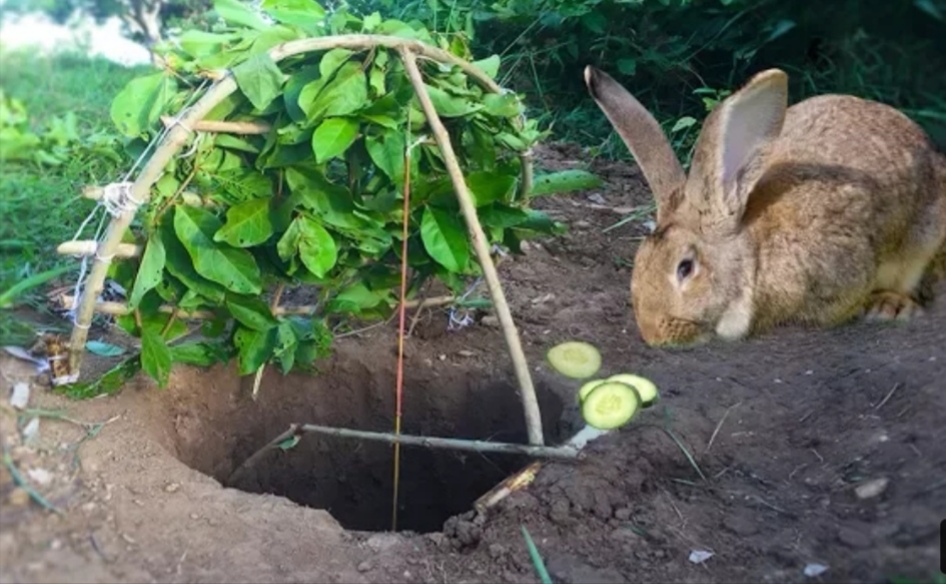
This image is for illustrative purposes. No rabbits were harmed in the production of the image
By Nick Kropacek 22 April 2019.
Links:
Will Lord. Master Flint Knapper and Prehistoric Survivalist.
For an excellent overview of the cosmology of the San, and other peoples across S. Africa, you can download this free book “Venus Rising” by Peter G Alcock of the South African Astronomical society.
http://assa.saao.ac.za/astronomy-in-south-africa/ethnoastronomy/venus-rising/
To visit Göbekli Tepe please visit: https://www.easternturkeytour.org/tour/gobekli-tepe/
